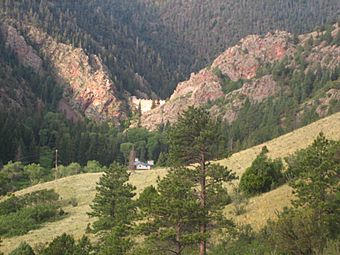Eagle Nest Dam facts for kids
|
Eagle Nest Dam
|
|

Eagle Nest Dam
|
|
| Nearest city | Eagle Nest, New Mexico |
|---|---|
| Area | 2,500 acres (1,000 ha) |
| Built | 1920 |
| Architect | Willis Ranney |
| NRHP reference No. | 79001537 |
Quick facts for kids Significant dates |
|
| Added to NRHP | April 18, 1979 |
The Eagle Nest Dam is a large dam located just east of the town of Eagle Nest, New Mexico. You can find it along U.S. Route 64. This dam holds back the water of the Cimarron River. It creates the beautiful Eagle Nest Lake.
Building the Dam: A Look Back
In 1907, two wealthy ranchers, Frank and Charles Springer, along with the Cimarron Valley Land Company, received a special permit. This permit allowed them to build a dam to collect water from the Cimarron River. The goal was to use this water for irrigation, which means watering crops.
Construction of the dam began in 1916 and finished in 1918. The dam stands about 140 feet (43 m) tall. It stretches 400 feet (120 m) across. At the very top, the dam is 9.5 feet (2.9 m) wide, but it gets much wider at its base, measuring 45.2 feet (13.8 m). This makes it the largest dam built by private owners in the United States.
The lake created by the dam is called Eagle Nest Lake. It covers an area of about 2,500 acres (10 km2; 3.9 sq mi). The lake is about 5 miles (8.0 km) long and 2 miles (3.2 km) wide. When the lake is full, its surface is 8,172 feet (2,491 m) above sea level. The lake can hold a huge amount of water, about 79,120 acre-feet (97,590,000 m3). Workers from the Taos Pueblo helped build this important dam. It got its name, Eagle Nest Dam, because eagles used to make their homes on the rocky sides of the dam. The dam is built between two strong granite walls. To build it, the Springers even had to move U.S. Route 64 to its current path over McAvoy Hill.
Who Owns the Water?
To help pay for the dam, the Springer family sold some of the water rights from Eagle Nest Lake. These rights were sold to local farmers and ranchers. These first rights are known as vested rights. This means they were officially given to those people.
In 1951, the State of New Mexico looked at all the water rights for the Cimarron River area. This process, called an adjudication, confirmed that the Springers had the right to store extra water and floodwater in Eagle Nest Lake. Over the years, there were many legal cases about these water rights. One important case even went to the New Mexico State Supreme Court in 1990.
Today, Eagle Nest Lake still provides water for its original purpose. It acts as a reservoir, holding water for irrigation. This water flows down the Cimarron River through a system of canals. Many farmers and ranchers use this water, some living as far as 50 miles away. Some of the water rights from Eagle Nest Lake have also been bought by nearby towns. These include Raton and Springer. The villages of Angel Fire, Eagle Nest, and Cimarron can also get their water from the lake.
The State Takes Over
In 2002, the State of New Mexico bought Eagle Nest Lake. Now, the New Mexico Interstate Stream Commission (ISC) manages it. However, the original water right owners still kept their rights to the water.
After the state bought the lake, different groups who used the water talked to Governor Bill Richardson. They hoped to find a way to stop the legal arguments over water rights. Governor Richardson and the local governments signed an agreement on June 2, 2006. This agreement is called the Eagle Nest Water Rights Settlement. It states that all water users will share if there are water shortages. How much each user gets is based on how much water is in the lake on June 1 each year. Everyone is treated fairly, even those who buy large amounts of water. The state also created the Eagle Nest Lake State Park. This park allows people to use the lake for fun activities like fishing and boating.


